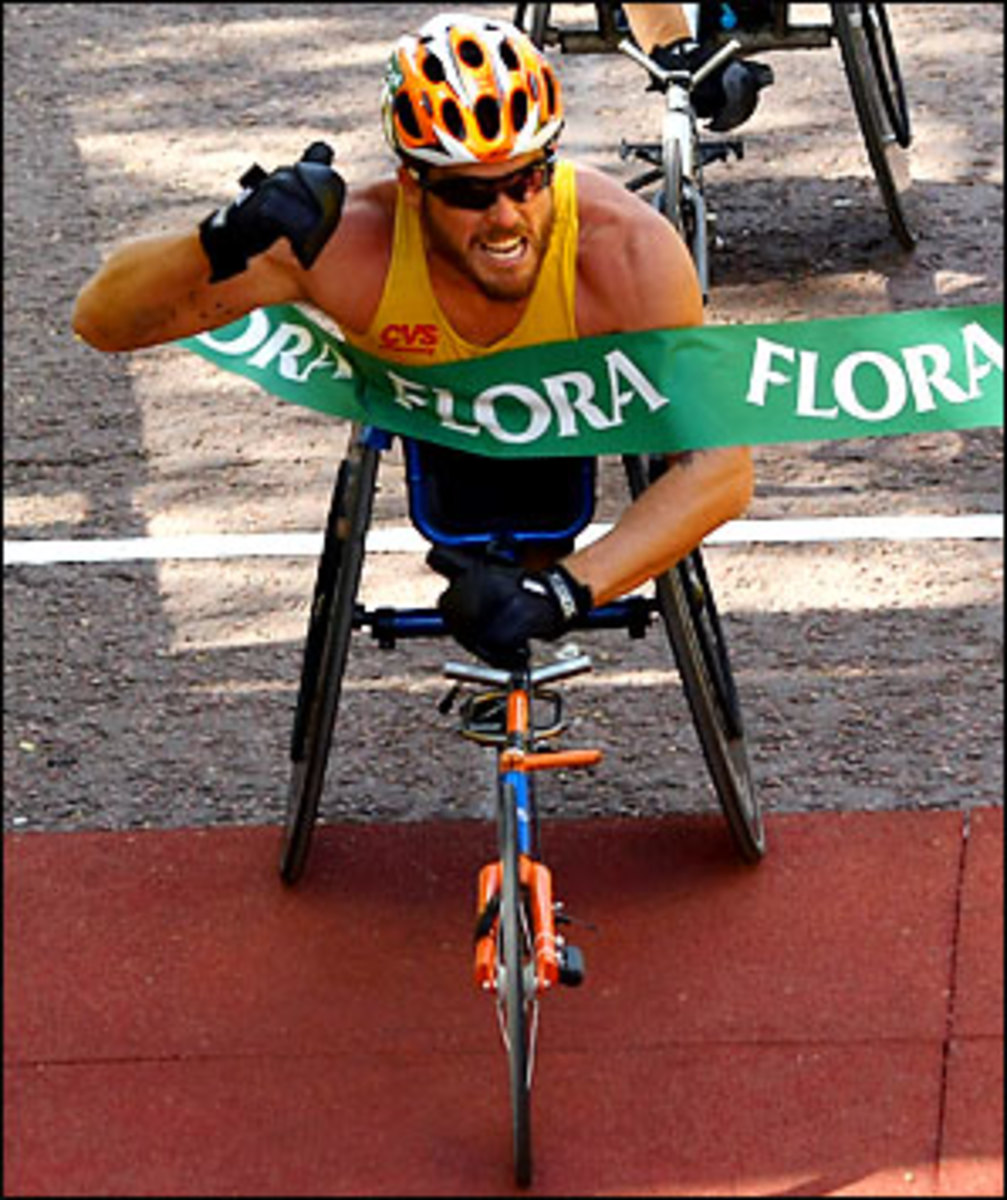My Sportsman: Kurt Fearnley


Sports Illustrated will announce its choice for Sportsman of the Year on Nov. 30. Here's one of the nominations for that honor by an SI writer.
If you have ever driven in New York City, you know it can take an hour to cover 20 blocks. Midtown, in the rain, during rush hour, is slower than that. On Nov. 1, Kurt Fearnley of Australia completed the 26.2 miles of the New York City Marathon course in one hour, 35 minutes and 58 seconds. Krige Schabort of Cedartown, Ga., had the exact same time, but Fearnley's wheelchair crossed the finish line a literal nanosecond ahead of Schabort's wheelchair, according to the photo finish. They both finished more than a half-hour ahead of the so-called able-bodied runners. Legged marathoners, if you prefer.
Fearnley is 28 and from the tiny town of Cowra, in New South Wales, Australia. He won the New York Marathon last year. He won a gold medal in the marathon at the 2004 Paralympics Games in Athens and did so again in the '08 Paralympic Games in Beijing. He wins most of the marathons in which he competes.
He is one of the most remarkable athletes in the world, whether you've heard of him or not. But that's not why I'm nominating him for Sportsman of the Year. He also has one of the most incredible personal stories of any elite athlete in the world, including his daily crawl to school as a kid in rural New South Wales. Fearnley has mini-legs, but they can't support his weight, and his daily crawl to school included wading through a river. But that's not why I'm nominating him for Sportsman of the Year.
Kurt Fearnley is my nominee for Sportsman of the Year because he is doing what few elite athletes -- few anybodies -- are willing to do: He has devoted himself to an issue that he sees as a matter of life and death. Actually, there are a number of good works that Fearnley is intimately involved with, and if you want to learn more about them I point you to his Web site, kurtfearnley.com. But here I'd like to point out just one, a group Fearnley supports called "Movember." Someday, when Movember is better known, Saturday Night Live or Mad magazine will have a field day with it. But in the meantime, this is what it is: an organization that encourages men, all over the world, to grow mustaches during the month of November for the purpose of calling attention to men's health issues, from prostate cancer to depression.
The idea, as Fearnley explained it to me, is that a man sees another man growing a mustache during November, asks him if he's involved in the Movember movement, and if he is, use that as an invitation, as Fearnley notes, "to discuss things that men don't normally talk about." The conversation could unfold in organized Movember meetings. But it could just as easily happen in a pub, on a bus or while walking down the sidewalk. Or wheeling down it, in Fearnley's case.
"I'm fortunate enough not to suffer from depression, but I know people who do, and how great is it that I can talk to other men about it?" Fearnley says. "That wasn't true just years ago. Especially in a macho culture like you find in Australia." Or in a macho culture you find wherever professional athletes congregate.
Fearnley has a great deal of experience in that regard, too. He makes his living as a wheelchair-bound marathoner. The wheelchairs are not what you see rolling around carpeted retirement homes. They are as high-tech as Tour de France bicycles. The athletes, at the elite level, are every bit as impressive, and in the wheelchair marathon the entrants jockey for position and occasionally crash into each other just as cyclists do. The main difference is that cyclists are propelled by their legs and wheelchair marathoners by their arms.
They all have some sort of disability from the waist down. Fearnley was born missing part of his lower spine. He has tiny feet and toothpick legs and the upper-body of a bantam weight boxer. When in the U.S., he buys shirts at Urban Outfitters and pants at Gap Kids, He weighs 110 pounds and can bench-press 230 pounds. "My wingspan is 6-feet-four," Fearnley says, as if he can fly, and he nearly can. During a marathon Fearnley's heart rate is, on average, about 200 beats per minute. An elite legged marathoner's is about 160 beats per minute.
If you find a fitter athlete who is more devoted to doing good, put him on the cover of Sports Illustrated for Sportsman of the Year. In mid-November, Fearnley spent 10 days crawling the Kokoda Track, a fiercely rugged, 60-mile jungle trail in Papua, New Guinea. He did it in the name of the Movember movement. His own mustache was pretty thick by the time he finished.
"Blokes don't like to talk about things that are important to them," he says. He gave examples: prostrate cancer, depression, alcohol abuse.
Fearnley's Movember mustache may not make it past Dec. 1. Right after the New York Marathon, Fearnley and his girlfriend, Sheridan Rosconi, went for a carriage ride in Central Park. When they came back, they were engaged. How Rosconi, who is able-bodied, feels about the mustache, Fearnley doesn't yet know.
Fearnley is a certified physical education teacher. His qualifications are vast. Challenge him to an arm wrestle, if you like. But be prepared: After he beats you, he's going to ask how you feel. And he'll mean it.
